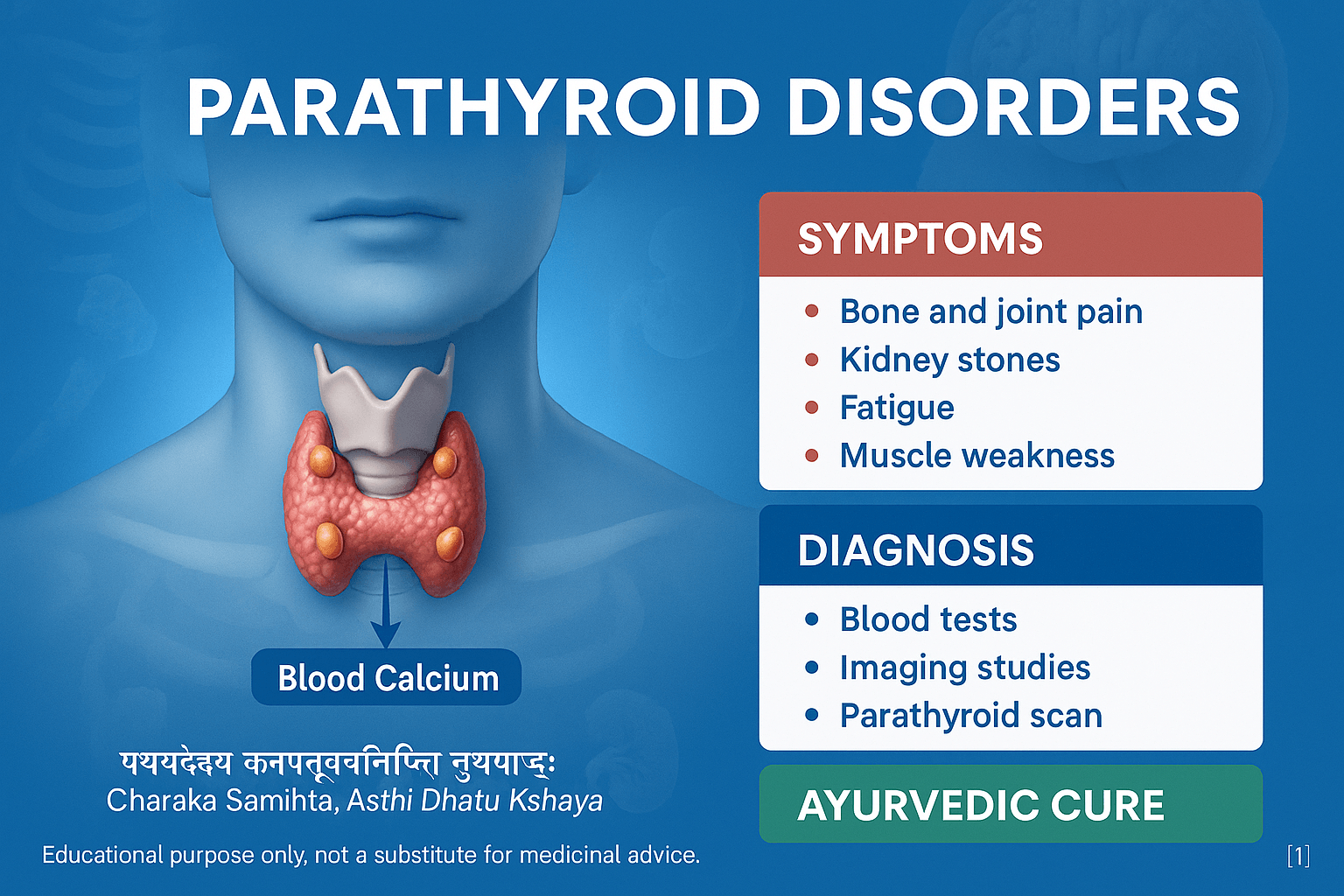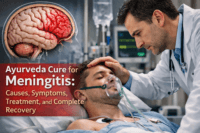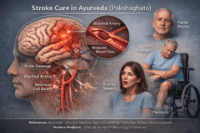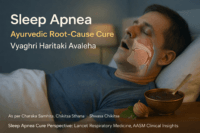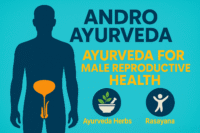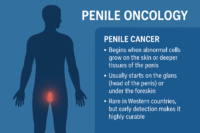- Anatomy and Physiology
- Pathophysiology
- Disorders of the Parathyroid
- Hyperparathyroidism
- Hypoparathyroidism
- Parathyroid Carcinoma
- Diagnostic Approaches
- Modern Medical Management
- Ayurveda Avaleha (Medicine) for Cure
- Name: Asthi-Majja-Ojas Rasayana Avaleha (Medicine)
- Ingredients
- Preparation Method (Avaleh Kalpana as per Bhaishajya Ratnavali)
- Dosage & Anupana
- Ayurvedic Action
- Disclaimer
- FAQs
- References
The parathyroid glands are four tiny endocrine structures located behind the thyroid gland, yet they play a crucial role in regulating calcium and phosphorus balance in the human body. Unlike the thyroid, which manages metabolism through thyroxine, the parathyroid glands secrete parathyroid hormone (PTH), a key regulator of bone strength, kidney function, and neuromuscular stability [1].
Disturbances in parathyroid function can lead to two opposite but equally dangerous conditions: hyperparathyroidism, where excess hormone causes calcium overload, kidney stones, and bone resorption, and hypoparathyroidism, where low hormone levels trigger tetany, seizures, and brittle bones [2]. Rarely, parathyroid cancer can arise, usually presenting with severe hypercalcemia and aggressive symptoms [3].
From an Ayurvedic perspective, parathyroid dysfunction may be correlated with Asthi Dhatu Kshaya (weakening of bone tissue), Majja Dhatu Dushti (marrow and nervous system imbalance), and Kapha-Pitta aggravation (stones, sluggish digestion, swelling) or Vata aggravation (tetany, cramps, dryness) [4]. Classical Ayurvedic texts emphasize maintaining calcium homeostasis through Rasayanas, mineral preparations like Praval Pishti, Mukta Sukti Bhasma, and Godanti Bhasma, and lifestyle measures such as sunlight exposure, diet, and stress regulation [5].
With rising cases of lifestyle disorders, thyroid–parathyroid surgeries, and chronic kidney disease, parathyroid disorders are becoming more prevalent worldwide. Modern medicine offers surgical and pharmacological interventions, while Ayurveda provides a holistic, root-cause–oriented approach that not only manages symptoms but also restores long-term balance [6].
Anatomy and Physiology
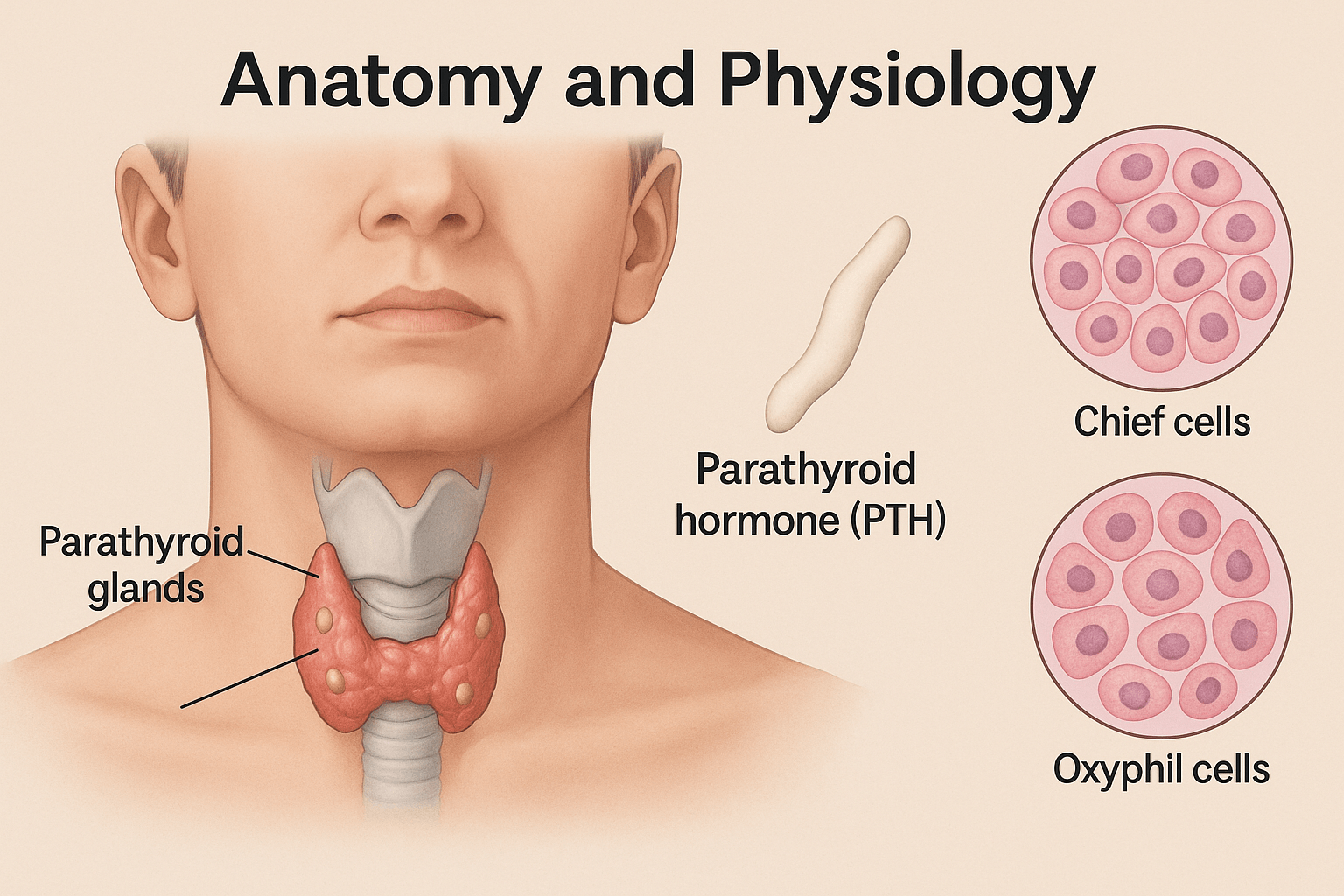
Structure of Parathyroid Glands
The parathyroid glands are typically four small, oval-shaped structures located on the posterior surface of the thyroid gland, though anatomical variations exist where individuals may have three or even five glands [1]. Each gland measures only a few millimeters in size yet carries immense importance for calcium balance. Unlike the thyroid, which is encapsulated and highly vascular, the parathyroid glands have a delicate capsule and are richly supplied with blood vessels to allow rapid hormone release into circulation [2].
Histology: Chief Cells and Oxyphil Cells
Microscopically, the parathyroid glands are composed primarily of two cell types. Chief cells are the most abundant and are responsible for the synthesis and secretion of parathyroid hormone (PTH). These cells contain numerous secretory granules, reflecting their endocrine function [3]. The second type, oxyphil cells, appear larger with an acidophilic cytoplasm rich in mitochondria. Their exact function remains less defined, though modern research suggests they may contribute to oxidative metabolism and possibly play a role in parathyroid hormone reserve [4].
Hormonal Function: Parathyroid Hormone (PTH)
The primary hormone secreted by the parathyroid glands is parathyroid hormone (PTH), a peptide consisting of 84 amino acids. PTH is a master regulator of serum calcium and phosphate levels, acting as a feedback mechanism when calcium levels drop in the bloodstream [5]. The release of PTH is tightly regulated by calcium-sensing receptors (CaSR) located on the parathyroid chief cells.
Role of PTH in Regulating Calcium, Phosphate, and Vitamin D
PTH increases serum calcium through three major mechanisms:
- Bone: Stimulates osteoclast activity indirectly via osteoblast signaling, leading to calcium release from bone matrix [6].
- Kidneys: Enhances calcium reabsorption in renal tubules while promoting phosphate excretion, preventing simultaneous hyperphosphatemia [7].
- Intestines: Indirectly increases calcium absorption by stimulating renal production of calcitriol (active vitamin D, 1,25-dihydroxycholecalciferol), which in turn promotes intestinal calcium uptake [8].
This finely tuned balance ensures adequate calcium availability for neuromuscular conduction, bone mineralization, and enzymatic functions. Disturbances in PTH secretion, therefore, have widespread systemic consequences.
From an Ayurvedic perspective, this regulation can be related to the dynamic interaction of Asthi Dhatu (bone tissue), Majja Dhatu (marrow and nervous system), and Shukra Ojas (vital essence). The parathyroid’s role in balancing calcium parallels the Ayurvedic concept of maintaining Dhatu Samya (tissue equilibrium), where disruption leads to conditions such as Asthi Kshaya (bone weakening) or Vata-related neuromuscular spasms [9].
Pathophysiology

Mechanism of Calcium Regulation
The parathyroid glands maintain calcium levels within a narrow physiological range (8.5–10.5 mg/dL). When serum calcium drops, calcium-sensing receptors (CaSR) on parathyroid chief cells are activated, stimulating the release of parathyroid hormone (PTH). PTH then works through bone, kidney, and intestines to restore calcium homeostasis [1]. Conversely, when calcium rises above normal, PTH secretion is suppressed, preventing hypercalcemia [2].
Interplay with Kidney, Bone, and Intestines
The action of PTH spans multiple organ systems:
- Bone: PTH stimulates osteoblasts to release RANKL, which activates osteoclasts, leading to the release of calcium and phosphate from bone into the blood. This ensures immediate calcium availability but contributes to bone resorption if prolonged [3].
- Kidneys: PTH promotes calcium reabsorption in the distal tubules, reduces phosphate reabsorption in the proximal tubules (preventing calcium-phosphate precipitation), and stimulates the conversion of 25-hydroxyvitamin D into active 1,25-dihydroxyvitamin D (calcitriol) [4].
- Intestines: The increase in calcitriol enhances calcium and phosphate absorption from the gut, supporting bone mineralization and systemic calcium balance [5].
Feedback Loop with Calcitonin and Vitamin D
Calcium regulation involves a delicate feedback loop. While PTH raises calcium, calcitonin—secreted by parafollicular cells (C-cells) of the thyroid—acts as a counter-regulatory hormone, lowering calcium by inhibiting osteoclast activity and increasing calcium deposition in bones [6]. In parallel, vitamin D plays a dual role: its active form, calcitriol, enhances intestinal calcium absorption but also provides negative feedback on the parathyroid gland to suppress excess PTH secretion [7].
This balance ensures that serum calcium remains stable, supporting neuromuscular conduction, cardiac rhythm, clotting mechanisms, and skeletal strength. Disturbances in any part of this axis—parathyroid glands, kidneys, bones, or vitamin D metabolism—result in clinical manifestations such as osteoporosis, kidney stones, or neuromuscular dysfunction [8].
From an Ayurvedic perspective, this dynamic interaction mirrors the Samyavastha (homeostasis) of Asthi Dhatu (bone tissue) and Majja Dhatu (nervous system and marrow). Disruption in this regulation can be correlated with Asthi Kshaya (bone weakening), Mutrashmari (urinary stones), and Vata-Pitta imbalance, where deranged fire (Agni) and obstructed channels (Srotas) disturb the equilibrium of mineral metabolism [9].
Disorders of the Parathyroid

The parathyroid glands, despite their small size, are responsible for maintaining calcium-phosphate balance. Dysfunction of these glands leads to three major clinical entities: hyperparathyroidism, hypoparathyroidism, and parathyroid carcinoma. Each has distinctive causes and symptom clusters that can severely affect multiple organ systems.
Hyperparathyroidism
Hyperparathyroidism happens when the parathyroid glands make too much parathyroid hormone (PTH). This hormone normally helps regulate calcium and phosphorus levels, but when produced in excess, it disrupts the body’s mineral balance.
There are three main types:
- Primary hyperparathyroidism is most often caused by a benign growth (adenoma) on one of the parathyroid glands. Less commonly, all glands may be enlarged (hyperplasia).
- Secondary hyperparathyroidism develops as a result of another condition, most often chronic kidney disease (CKD). In CKD, the kidneys can’t properly regulate calcium and phosphate, which overstimulates the parathyroid glands.
- Tertiary hyperparathyroidism occurs when long-term secondary hyperparathyroidism becomes autonomous, with the glands continuing to release excess hormone even after the underlying problem is addressed.
Symptoms can vary widely, but the classic presentation is described as “stones, bones, groans, and psychic moans.”
- Stones: kidney stones, frequent urination, and calcium buildup in the kidneys.
- Bones: bone pain, fractures, and osteoporosis.
- Groans: abdominal discomfort, nausea, constipation, and sometimes pancreatitis.
- Psychic moans: depression, fatigue, and memory problems.
Other symptoms may include muscle weakness, hypertension, and generalized fatigue. If left untreated, complications such as severe bone loss, kidney damage, and cardiovascular problems can occur.
Hypoparathyroidism
Hypoparathyroidism is the opposite problem. It occurs when the parathyroid glands do not produce enough PTH. Without this hormone, calcium levels in the blood drop too low, while phosphate levels rise.
The most common cause is accidental damage or removal of the parathyroid glands during thyroid or neck surgery. Autoimmune conditions, genetic mutations, and certain metabolic disorders can also lead to hypoparathyroidism.
Symptoms are mainly related to low calcium (hypocalcemia) and include:
- Tingling or numbness in the lips, fingers, and toes.
- Muscle cramps, spasms, or painful contractions.
- Twitching of the facial muscles (Chvostek’s sign) or hand spasms when the arm is compressed (Trousseau’s sign).
- In more severe cases, seizures.
Over time, patients may also develop brittle nails, dry skin, coarse hair, and dental abnormalities. Psychological changes such as anxiety, irritability, and depression are also common. If untreated, hypoparathyroidism can cause chronic neuromuscular symptoms, calcification in soft tissues, and impaired quality of life.
Treatment usually involves calcium and vitamin D supplementation, and in some cases synthetic PTH therapy. Lifelong monitoring is typically required.
Parathyroid Carcinoma
Parathyroid carcinoma is a very rare but serious cancer of the parathyroid glands. It accounts for less than 1% of cases of primary hyperparathyroidism. Unlike benign adenomas, this tumor can invade nearby tissues and spread to other organs.
The exact cause is unknown, but certain inherited syndromes such as multiple endocrine neoplasia type 1 (MEN1) and mutations in the HRPT2 gene increase the risk.
Symptoms are usually more severe than in benign parathyroid disease because the tumor produces extremely high levels of PTH, leading to dangerous hypercalcemia. Common signs include:
- Persistent nausea, vomiting, dehydration, and confusion.
- A noticeable lump in the neck.
- Hoarseness or difficulty swallowing if the tumor presses on surrounding structures.
- Severe bone pain and fractures due to calcium loss.
Because symptoms often overlap with benign hyperparathyroidism, diagnosis can be challenging. Blood calcium and PTH levels are usually extremely elevated, and imaging may reveal a neck mass.
Treatment typically requires surgical removal of the cancerous gland along with surrounding tissue. Even with surgery, recurrence is common, and patients need close long-term monitoring.
Diagnostic Approaches
Diagnosing parathyroid disorders usually starts with simple blood work and then moves on to imaging and bone testing if needed. Doctors use these tools to confirm whether the glands are working properly and to check the effects of abnormal hormone levels.
Blood tests
The first step is usually blood testing. High or low calcium levels are a key sign of parathyroid problems. Other markers include phosphate, parathyroid hormone (PTH), and vitamin D. For example, high calcium and high PTH suggest hyperparathyroidism, while low calcium and low PTH point toward hypoparathyroidism.
Imaging
If a parathyroid tumor or enlarged gland is suspected, imaging can help locate the problem. Ultrasound of the neck is commonly used because it’s safe and non-invasive. A sestamibi scan is more specific, using a small radioactive tracer to highlight overactive parathyroid tissue. In difficult cases, advanced imaging such as MRI or CT scans may be used.
Bone mineral density testing
Because parathyroid disorders can weaken the bones, doctors often recommend a bone mineral density (DEXA) scan. This test measures bone strength and can reveal early osteoporosis or fracture risk, even before symptoms appear.
Modern Medical Management

Treatment for parathyroid disorders depends on whether the glands are overactive, underactive, or affected by cancer. The main goal is to restore normal calcium balance while preventing long-term complications.
Hyperparathyroidism
The most effective treatment for primary hyperparathyroidism is surgery to remove the overactive gland. Parathyroidectomy is usually recommended if calcium levels are very high, if bone or kidney complications are present, or if the patient is young.
For people who cannot have surgery, medications may help. Calcimimetics, such as cinacalcet, reduce parathyroid hormone release and lower calcium levels. Bisphosphonates may be prescribed to protect bone strength by slowing down calcium loss from bones.
Hypoparathyroidism
Management focuses on raising calcium levels and keeping them stable. Most patients take lifelong calcium supplements along with active forms of vitamin D to improve calcium absorption. In some cases, recombinant parathyroid hormone (PTH) injections are used, particularly when standard supplements are not enough to control symptoms.
Parathyroid cancer
Treatment is more complex because the disease is rare and often aggressive. Surgery is the main option, with complete removal of the cancerous gland and sometimes surrounding tissue. After surgery, patients may still need supportive therapies to manage persistent high calcium levels, which can include hydration, bisphosphonates, or calcimimetics. Long-term monitoring is essential because the cancer often comes back.
Ayurveda Avaleha (Medicine) for Cure
Name: Asthi-Majja-Ojas Rasayana Avaleha (Medicine)
Ingredients
Main Herbal Interventions
- Ashwagandha (Withania somnifera) – Vata pacifying, bone/muscle strength
- Arjuna (Terminalia arjuna) – Asthi support, cardiac protection
- Shatavari (Asparagus racemosus) – Pitta pacifying, nourishes dhatus
- Guduchi (Tinospora cordifolia) – Tridosha balancing, Rasayana, immunomodulator
- Amalaki (Emblica officinalis) – Potent Rasayana, antioxidant, calcium absorption enhancer
- Bala (Sida cordifolia) – Neuromuscular support, Vata pacifier
- Gokshura (Tribulus terrestris) – Supports urinary tract, prevents stones
- Varun (Crataeva nurvala) – Specific for Mutrashmari (urinary calculi)
- Punarnava (Boerhavia diffusa) – Diuretic, balances Kapha and Pitta
- Manjistha (Rubia cordifolia) – Rakta Shodhana (blood purifier)
- Sariva (Hemidesmus indicus) – Rakta Dushti correction, cooling, Pitta pacifier
Mineral Formulations (Shuddha and classical)
- Praval Pishti (Coral calcium) – Natural calcium source, bone strengthening
- Mukta Bhasma / Mukta Sukti Bhasma (Pearl/oyster shell calx) – Calcium rich, cooling
- Godanti Bhasma (Gypsum calx) – Pitta pacifier, calcium supply
- Abhrak Bhasma (Mica calx) – Majja Rasayana, improves nerve and marrow health
- Lauh Bhasma (Iron calx) – Rakta dhatu support, strengthens Ojas
- Swarnamakshik Bhasma (Chalcopyrite calx) – Supports metabolism and endocrine functions
- Rajata Bhasma (Silver calx) – Nervine tonic, cooling, Rakta protector
- Svarna Bhasma (Gold calx) – Rasayana, enhances immunity and Ojas
- Trivanga Bhasma (Lead, Tin, Zinc compound) – Corrects metabolic imbalances
- Sphatika Bhasma (Alum calx) – Cooling, Rakta Shodhana, stone prevention
Rasayana Supports
- Amalaki Rasayana – Base Rasayana
- Gandhak Rasayan (purified sulfur Rasayana) – Tissue rejuvenator
- Chyawanprash (optional) – Classic Avaleha base if desired
Base & Carriers
- Cow’s Ghee (Go Ghrita) – Enhances Rasayana effect, pacifies Vata
- Jaggery (Guda) or Sharkara (Sugar) – Sweet base, stabilizes formulation
- Honey (Madhu) – Yogavahi (catalyst), increases tissue penetration
Dietary Powders
- Sesame seed (Tila) powder – Rich in calcium and oil, supports Asthi dhatu
- Drumstick leaf (Moringa) powder – Calcium, vitamin D, and micronutrients
- Prepare a decoction (Kwatha) with Ashwagandha, Arjuna, Shatavari, Guduchi, Amalaki, Bala, Gokshura, Varun, Punarnava, Manjistha, Sariva (16 parts water, reduced to 1/4th).
- Add jaggery/sugar to the decoction and boil until Avaleha consistency forms.
- Incorporate cow’s ghee slowly while stirring.
- At the final stage, add all mineral formulations (Praval, Mukta Sukti, Godanti, Abhrak, Lauh, Swarnamakshik, Rajata, Svarna, Trivanga, Sphatika Bhasma) + Amalaki Rasayana and Gandhak Rasayan.
- Allow to cool slightly, then add honey.
- Mix in sesame seed powder and drumstick leaf powder.
- Store in an airtight glass container.
Dosage & Anupana
- Dose: 10–15 g twice daily
- Anupana (vehicle): Warm milk or lukewarm water
- Course: 3–6 months under supervision
Ayurvedic Action
- Rasayana – rejuvenates tissues, restores Ojas
- Asthi Dhatu Poshaka – nourishes bone tissue (Praval, Mukta, Godanti, Sesame)
- Majja Rasayana – supports marrow and nerves (Abhrak, Ashwagandha, Shatavari)
- Rakta Shodhana – blood purification, tumor prevention (Manjistha, Sariva, Sphatika)
- Mutravaha Srotas Shuddhi – prevents stones, protects kidneys (Gokshura, Varun, Punarnava)
- Ojasvardhaka – boosts immunity and vitality (Svarna, Rajata, Gandhak Rasayan)
Indications
- Hyperparathyroidism – prevents bone resorption, balances calcium, reduces stones
- Hypoparathyroidism – relieves spasms, tetany, neuromuscular irritability
- Parathyroid cancer – Rasayana and Rakta Shodhana for recurrence prevention, immune strengthening
Disclaimer
This content is for educational purposes only and is not intended to replace professional medical advice, diagnosis, or treatment. Always seek the guidance of a qualified healthcare provider with any questions regarding a medical condition. Ayurvedic formulations and therapies mentioned here are based on classical medical texts and traditional practices, and should be used only under the supervision of a licensed Ayurvedic physician. Do not self-medicate with mineral or herbo-mineral preparations (Bhasmas, Rasayanas) without proper purification and dosage guidance.
In Ayurveda, treatment is personalized. The formulation, dosage, and supporting therapies may change based on Prakriti (body constitution), Vikriti (current imbalance), age, strength, digestion, and individual body response. Ayurveda does not follow a “one-size-fits-all” model.
If you are pregnant, nursing, have chronic illnesses, or are taking prescription medications, consult both your Ayurvedic and allopathic healthcare providers before starting any new treatment. The author and publisher are not responsible for any adverse effects resulting from misuse of information provided in this article.
FAQs
1. What are the main symptoms of parathyroid disorders?
Parathyroid disorders present differently depending on hormone imbalance. Hyperparathyroidism often causes kidney stones, bone pain, fatigue, and digestive issues [7]. Hypoparathyroidism leads to muscle cramps, tetany, tingling around the mouth and extremities, and in severe cases, seizures [8].
2. How are parathyroid disorders diagnosed?
Diagnosis involves blood tests for calcium, phosphate, vitamin D, and PTH. Imaging such as ultrasound or sestamibi scans helps detect abnormal glands, while bone density scans reveal osteoporosis or bone weakening [9].
3. Are parathyroid disorders common?
They are not as common as thyroid disorders but are increasingly seen due to lifestyle changes, rising cases of chronic kidney disease, and complications from thyroid surgeries affecting the parathyroid glands [10].
4. What is the difference between hyperparathyroidism and hypoparathyroidism?
Hyperparathyroidism results from excess PTH, raising calcium levels in the blood. Hypoparathyroidism is due to insufficient PTH, causing low calcium and symptoms of neuromuscular irritability [11].
5. Can Ayurveda help in parathyroid disorders?
Yes. Ayurveda provides holistic management by correcting dosha imbalances and nourishing dhatus. Remedies include Praval Pishti, Mukta Sukti Bhasma, Godanti Bhasma, and herbs like Ashwagandha, Guduchi, and Shatavari, which support calcium metabolism and bone strength [12].
6. Is surgery always needed for parathyroid problems?
Surgery is the primary treatment for severe primary hyperparathyroidism or cancer. However, milder cases may be managed through monitoring, medication, dietary changes, and supportive Ayurvedic therapies [13].
7. What diet is recommended for parathyroid disorders?
A calcium-rich diet is essential, including milk, sesame, leafy greens, and drumstick leaves. Sunlight exposure is vital for vitamin D. Ayurveda advises limiting sour and salty foods in hyperparathyroidism, while hypoparathyroidism patients benefit from warm, nourishing meals [14].
8. Are Ayurvedic mineral formulations safe?
Classically prepared Bhasmas, when properly purified according to Rasashastra, are considered safe and effective. However, they must only be taken under the supervision of an Ayurvedic physician to avoid misuse or heavy metal toxicity [15].
9. What happens if parathyroid disorders are left untreated?
Neglected cases can lead to osteoporosis, recurrent kidney stones, neuromuscular complications like seizures, and even cardiovascular problems. Timely treatment in either modern or Ayurvedic medicine prevents progression [16].
10. Can parathyroid disorders be prevented?
Complete prevention is not always possible, but lifestyle modification helps. Adequate calcium and vitamin D intake, regular sunlight exposure, and Ayurvedic Rasayana therapies strengthen bone and glandular function, reducing susceptibility [17].
References
- Roumpou, A., & et al. (2025). Bone in Parathyroid Diseases Revisited. Endocrine Reviews, 46(4), 576-596. https://doi.org/10.1093/edrv/8104766
- Lee, M., & et al. (2019). Parathyroid hormone signaling in bone and kidney. Journal of Endocrinology, 241(2), R1-R14. https://doi.org/10.1530/JOE-18-0585
- Taniegra, E.D. (2004). Hyperparathyroidism. American Family Physician, 69(2), 333-339. https://www.aafp.org/pubs/afp/issues/2004/0115/p333.html
- Rejnmark, L., & et al. (2024). Treatment of hypoparathyroidism by re-establishing calcium homeostasis. Endocrinology and Metabolism, 39(1), 13-22. https://doi.org/10.3803/EnM.2024.1916
- Shankar, D., & Valiathan, M.S. (2007). Concepts and principles of Ayurveda. Ancient Science of Life, 26(3), 1-8. https://www.ncbi.nlm.nih.gov/pmc/articles/PMC3336313/
- Sharma, R.K., & Dash, B. (Eds.). (2005). Charaka Samhita (Vol. 2: Chikitsa Sthana, Asthi Dhatu Kshaya Adhyaya). Chowkhamba Sanskrit Series.
- Ureña-Torres, P., & et al. (2018). Report of The Parathyroid Day in Chronic Kidney Disease. Frontiers in Medicine, 5, 183. https://doi.org/10.3389/fmed.2018.00183
- Brandi, M.L., & et al. (2016). Management of hypoparathyroidism: summary statement and guidelines. Journal of Clinical Endocrinology & Metabolism, 101(6), 2273-2283. https://doi.org/10.1210/jc.2015-3907
- Fraser, W.D. (2009). Hyperparathyroidism. Lancet, 374(9684), 145-158. https://doi.org/10.1016/S0140-6736(09)60507-9
- Yeh, M.W., & et al. (2013). Surgery for primary hyperparathyroidism: a review. JAMA, 310(24), 2601-2610. https://doi.org/10.1001/jama.2013.282341
- Ketteler, M., & et al. (2025). Chronic kidney disease–mineral and bone disorder. Kidney International, 107(2), 192-208. https://doi.org/10.1016/j.kint.2024.11.018
- Indu, S., Kumar, P.A., Rao, S.K., & Jayaram, H. (2019). Ayurvedic perspective of calcium supplementation: A review. Vitamins & Minerals, 8, Article 185. https://www.researchgate.net/publication/341296797
- Khan, A.A., & et al. (2017). Standards of care for hypoparathyroidism in adults. Nature Reviews Endocrinology, 13, 550-561. https://doi.org/10.1038/nrendo.2017.56
- Bhadada, S.K., & et al. (2011). Dietary calcium intake and serum vitamin D in patients with primary hyperparathyroidism. Indian Journal of Endocrinology and Metabolism, 15(4), S141-S145. https://doi.org/10.4103/2230-8210.84863
- Joshi, N., & et al. (2015). Standardization and quality control parameters for Muktā (pearl) Bhasma/Pishti. Ancient Science of Life, 34(3), 138-143. https://doi.org/10.4103/0257-7941.157152
- Singh, A., Dubey, S.D., Patney, S., Kumar, V., & et al. (2010). Acute and subchronic toxicity study of calcium-based Ayurvedic Bhasmas and Pishti prepared from marine animals. Journal of Herbal Medicine & Toxicology, 4(1), 35-47. https://www.researchgate.net/publication/268432951
- Reddy, P.N., Lakshmana, M., & et al. (2003). Effect of Praval Bhasma (coral calx) in prevention of calcium and estrogen-deficient bone loss. Journal of Ethnopharmacology, 84(2-3), 259-264. https://doi.org/10.1016/S0378-8741(02)00327-2
- Kamble, S., Wanjari, A., Rathi, B., & Rajput, D. (2021). Pharmaceutico-analytical study of Muktashukti Pishti and Bhasma and comparative evaluation of oral bioavailability. Journal of Pharmaceutical Research International, 33(31B), 1-9. https://doi.org/10.9734/jpri/2021/v33i31B31680
- Patgiri, B., & Prajapati, P.K. (2015). Safety and efficacy of Ayurvedic mineral preparations. Ancient Science of Life, 34(1), 1-9. https://doi.org/10.4103/0257-7941.150771
- Valiathan, M.S. (2009). The Legacy of Charaka. Orient Blackswan.



